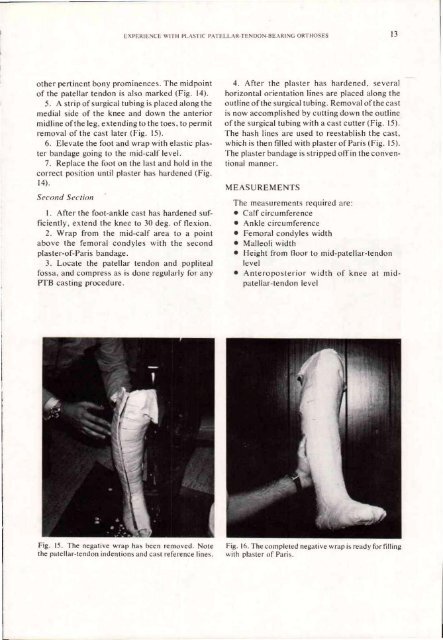Orthotics and Prosthetics
Orthotics and Prosthetics
Orthotics and Prosthetics
You also want an ePaper? Increase the reach of your titles
YUMPU automatically turns print PDFs into web optimized ePapers that Google loves.
other pertinent bony prominences. The midpoint<br />
of the patellar tendon is also marked (Fig. 14).<br />
5. A strip of surgical tubing is placed along the<br />
medial side of the knee <strong>and</strong> down the anterior<br />
midline of the leg, extending to the toes, to permit<br />
removal of the cast later (Fig. 15).<br />
6. Elevate the foot <strong>and</strong> wrap with elastic plaster<br />
b<strong>and</strong>age going to the mid-calf level.<br />
7. Replace the foot on the last <strong>and</strong> hold in the<br />
correct position until plaster has hardened (Fig.<br />
14).<br />
Second<br />
Section<br />
1. After the foot-ankle cast has hardened sufficiently,<br />
extend the knee to 30 deg. of flexion.<br />
2. Wrap from the mid-calf area to a point<br />
above the femoral condyles with the second<br />
plaster-of-Paris b<strong>and</strong>age.<br />
3. Locate the patellar tendon <strong>and</strong> popliteal<br />
fossa, <strong>and</strong> compress as is done regularly for any<br />
PTB casting procedure.<br />
4. After the plaster has hardened, several<br />
horizontal orientation lines are placed along the<br />
outline of the surgical tubing. Removal of the cast<br />
is now accomplished by cutting down the outline<br />
of the surgical tubing with a cast cutter (Fig. 15).<br />
The hash lines are used to reestablish the cast,<br />
which is then filled with plaster of Paris (Fig. 15).<br />
The plaster b<strong>and</strong>age is stripped off in the conventional<br />
manner.<br />
MEASUREMENTS<br />
The measurements required are:<br />
• Calf circumference<br />
• Ankle circumference<br />
• Femoral condyles width<br />
• Malleoli width<br />
• Height from floor to mid-patellar-tendon<br />
level<br />
• Anteroposterior width of knee at midpatellar-tendon<br />
level<br />
Fig. 15. The negative wrap has been removed. Note<br />
the patellar-tendon indentions <strong>and</strong> cast reference lines.<br />
Fig. 16. The completed negative wrap is ready forfilling<br />
with plaster of Paris.
















